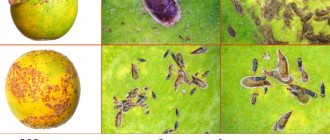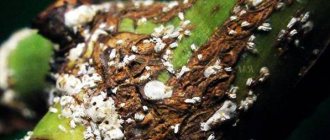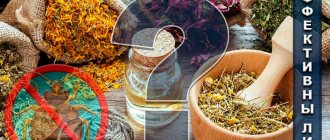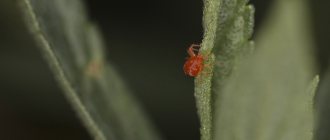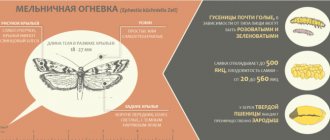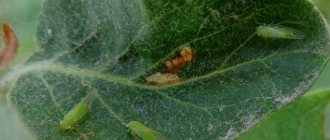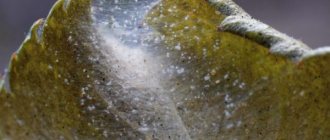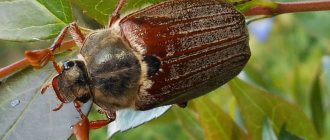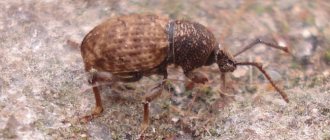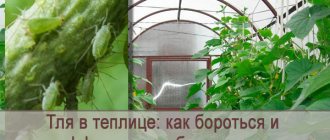Currants are unpretentious and can grow in almost any soil. In order to get good harvests, it is necessary to carry out the usual agrotechnical practices in a timely manner - watering and feeding. Regular pest and disease control is necessary. Representatives of the currant family can be damaged by more than 70 species of insects. Often, scale insects are found on berry bushes - a sucking pest that feeds on the juices of branches, leaves and shoots. This dangerous insect can destroy all the currant bushes in the garden if you do not take action and start fighting it in a timely manner.
Description of the pest
Scale insects belong to the coccids, a superfamily of insects. There are many known species of this representative of the order Hemiptera; currants are attacked by:
- Comma-shaped scale insect.
- Willow scale insect.
- Acacia false scale.
They differ in size and color; a common feature is the presence of a dense wax shield that protects the body of an adult pest. The false scale insect, unlike the ordinary scale insect, easily parted with its shell.
Female coccids are capable of bearing huge offspring without the need for fertilization. Having laid eggs, she dies, and the “armor” left behind by the female protects the offspring from destruction.
The false scale insect lays eggs after the currant blossoms.
After overwintering, the pest hatches from eggs in May–June, when apple trees begin to bloom. The emerging larvae are called “strays” and are less than a millimeter in size. The larvae crawl throughout the plant, looking for a suitable place to feed.
Heavy rain significantly reduces the number of “vagrants”.
Pests prefer leaves, located on their veins on the inside and outside. Scale insects can often be seen on stems and trunks. The stuck “tramp” is undergoing changes.
Most of the larvae turn into females. The role of males in procreation is insignificant, so few of them are born.
The female larva can no longer move, and a waxy shell begins to grow around her body. The older the pest, the denser its shell. Females have a well-developed oral apparatus of the sucking-piercing type, but lack eyes and organs of locomotion. Males can move, but they are deprived of the opportunity to feed.
Pests feed on plant sap, absorbing proteins from it. The honeydew they secrete, a sweet sticky secretion, is clearly visible on the plants.
Honeydew attracts ants.
What does it look like
Pests covered with waxy shells resemble scales. The “armor” of pseudoscale insects is yellowish-brown; other representatives of coccids have shells painted in grayish shades.
Large colonies of pests are often mistaken for ordinary growths on the trunk.
What harm does currants cause?
Scale insects feed on plant juices, weakening them. This leads to a decrease in yield and the death of currant shoots. If the pest is not controlled, it can completely destroy the bush.
Symptoms of the lesion
The little larvae are difficult to notice with the naked eye. When the pest becomes active, traces of its activity will be obvious:
- Sticky spots on currant leaves.
- Dense plaques on different parts of the bush.
It is necessary to inspect the lower parts of the leaves and the places where the leaf cuttings adjoin the branch.
Consequences
Once in favorable conditions, insects can completely occupy the currant bush. They suck out the nutritious juice, causing premature yellowing and shedding of the leaves.
The plant does not develop, the quality of the fruit deteriorates. If measures are not taken, the weakened plant will not be able to prepare for the next growing season and will die.
The absence of frost in winter and extremely hot summers are ideal conditions for the spread of scale insects.
What harm do they cause?
The types of parasites in question cause enormous damage to vegetation . In just a couple of years they can destroy entire currant plantations.
Pests feed on the cell sap of shoots, leaves and berries. As a result, the bushes begin to dry out. In the absence of timely treatment, complete death of the plant is observed. After the pests destroy one currant bush, they move to a specimen that is nearby.
How to fight and get rid of scale insects on currants
A kind of armor reliably protects adult pests and their eggs. Therefore, different methods are used to combat them:
- mechanical;
- chemical;
- folk remedies.
If there are few “shields” on the bush, you can try to remove them mechanically, peeling them off the branches and leaves. You need to put a newspaper under the bush in order to later destroy the pests that have fallen on it.
You can put a rubber glove on your hand, and on top pull a cloth mitten moistened with soapy water.
For chemical control, systemic pesticides and insecticides that can penetrate the protective shield are suitable. These drugs are recommended for use at the beginning and end of the growing season.
Folk remedies work well as long as the pest is not protected. They can be used throughout the growing season.
The time of emergence of larvae from eggs is somewhat different for different types of scale insects. From mid-May to mid-July, you need to regularly inspect the bushes in order to promptly identify “shields” in the initial stage of their formation.
Processing rules:
- In the morning or evening hours.
- No rain is forecast for the next 4 hours after spraying.
Chemical
Just one treatment with a properly selected drug will help get rid of scale insects. The choice of chemical depends on the processing time:
- Systemic drugs are used in the spring.
- Ovicidal drugs are used in spring and autumn.
Treatment is carried out at an air temperature of at least 4 °C. Use a freshly prepared solution.
Intraplant (systemic) drugs penetrate into the cell sap of the plant. The larva, feeding on plant sap, receives a portion of poison and dies. After treatment, the toxin circulates in the plant tissues for about a month.
Systemic drugs include pesticides from the neonicotinoid group:
- Aktara;
- Tanrek;
- Colorado;
- Apache.
Systemic preparations are used for spraying and watering plants.
Ovicidal drugs are destructive to insect eggs. Organophosphate pesticides have this property. For processing currants it is recommended:
- Actellik.
It is not recommended to use the same product twice in a row.
Aktellik
A very strong toxic drug. It contains pirimiphos-methyl and is classified as an organophosphorus compound. Actellik is a pesticide of fumigant and enteric contact type. The poison penetrates the body's cells through the respiratory tract, insect integument and intestinal tract. Affects oviposition. The insect dies within a few hours.
The drug is sold in the form of an emulsion in ampoules of 2–5 ml. Dosage for spraying:
- 2 ml per 2 liters of water.
Droplets of the emulsion, falling on the shell of the scale insect, are able to penetrate through it and infect the pest and its eggs.
Disadvantages of the drug:
- unpleasant odor;
- Toxicity class 2, protective measures are required during processing.
Aktara
A systemic neonicotinoid insecticide contains imidacloprid. The poison infects the insect through the esophagus when it feeds on the juices of the plant.
The substances included in the preparation ensure translaminar transport of imidacloprid - it quickly enters all parts of the plant and remains in them for a long time.
The drug penetrates the plant through the roots, leaves and bark. It blocks the transmission of nerve impulses in muscle tissue. The insect stops feeding and quickly dies from exhaustion.
The scale insect dies within two days after treatment.
Aktara against the Colorado potato beetle and other pests is sold in powder form in packages of 4 grams and in ampoules containing 1.2 ml of emulsion. The working solution is prepared at the rate of 1 g of powder or 1 ampoule per 1 liter of water. Currants are sprayed and the ground is watered in the root circle.
The insecticide is dangerous for bees. You can spray only before flowering.
Tanrek
This systemic insecticide is used for spraying and watering. It contains imidacloprid, which has a paralyzing effect on the pest. Read about the instructions for using tanrek against pests here.
It is analogous to Aktara.
Tanrek is sold in ampoules that contain 1 ml of the substance. To prepare a working solution, it is diluted in 2 liters of water. Currants are sprayed and watered in early spring.
Colorado
A systemic insecticide containing imidacloprid as an active substance. Its effect on pests is similar to Aktara.
The drug is available in different packages; the spray solution is prepared based on:
- 1 ml of Colorado per 5 liters of water.
Apache
This systemic insecticide of the latest generation is characterized by economical consumption and high efficiency. Apache contains clothianidin, which has a paralyzing effect on the pest half an hour after contact with it. Read about Apaches from the Colorado potato beetle.
The release form of the drug is granules, packaged in 0.5 gram bags. One package contains 5 sachets. Scheme for preparing the solution:
- 1 g per 1 liter of water.
Folk remedies
Environmentally friendly folk remedies can be used throughout the growing season. They have more of a preventive effect.
Decoctions can be stored for a month in a cool place. Infusions must be used within a week.
You can spray the plant with the prepared solutions and wash it. Treatment should be carried out twice a week for a month.
These remedies work if the plant is only slightly infected. With a massive invasion of scale insects, only “chemistry” will help.
Tobacco dust
The drug, made from tobacco production waste, contains many useful elements (nitrogen, potassium, phosphorus) and the poison nicotine.
Tobacco dust can both fight pests and nourish the plant, increasing its immunity.
Preparation of infusion for spraying:
- Pour 80 g of tobacco dust into 1 liter of hot water.
- Leave for a day.
- Before use, add liquid soap or washing powder.
If there is no tobacco dust, you can infuse cigarette butts.
Laundry soap
A soap and oil solution helps to cope with scale insects. It creates a film that makes it impossible for the insect to breathe. Preparation of the solution:
- 1 part soap solution and 3 parts sunflower oil.
To obtain a soap solution, 30 g of soap must be dissolved in a liter of hot water.
The resulting emulsion must be applied to the leaves and shoots of currants for 10 hours, and then washed off with water. It is advisable to repeat this procedure after a week. Treatment should be carried out in the morning on a cloudless day. Read how to dilute laundry soap against aphids on currants here.
When carrying out early spring scalding, you can dissolve 100 g of grated soap in 10 liters of hot water. After the procedure, you need to “clean” the currant branches with a toothbrush.
Green soap
Green soap contains potassium salts of fatty acids, animal and vegetable fats. When spraying currants, a dense film is formed on its parts, which impedes the life of the scale insect. It is advisable to carry out the treatment twice with a period of 7 days with a solution containing:
- 50 g of soap in 10 liters of water.
Some gardeners claim that there is no need to wash off the composition from the bushes. Night dew and rain will wash away the currants.
Garlic solution
Garlic is traditionally used to control pests. The fungicides contained in this vegetable repel insects. To prepare the infusion use:
- 10 chopped garlic cloves;
- A glass of warm water.
Leave for two days, then treat the bush.
You can add soap, green or laundry soap, to the infusion for better adhesion.
Wood ash
Caustic alkali, resulting from the dissolution of ash in water, has a detrimental effect on young scale insect larvae. Preparation:
- Pour 300 g of ash with a liter of boiling water.
- Boil for half an hour.
- Dilute the decoction in 10 liters of water.
Pepper infusion
Pepper contains alkaloids, the strongest biological poisons. First you need to prepare a decoction of hot pepper:
- Boil 50 g of fresh or 10 g of dry material in 500 ml of water.
Then the decoction must be infused for 24 hours. To prepare the working solution you need to use:
- 1 tbsp. a spoonful of infusion;
- 1 liter of water;
- 1 tsp. liquid soap.
Use of chemicals
In the fight against scale insects on black currants, contact neonicotinoids perform best. And the most popular and effective of these drugs are:
- "Aktara";
- "Colorado";
- "Apache";
- "Mospilan";
- "Tanrek."
In order to treat infected plants, the insecticide must first be diluted in water in the proportions prescribed in the instructions. Then the working solution is poured into a bucket and the currant bush is immersed in it. It is important that the liquid covers all branches and leaves. Plants can simply be sprayed, but, as practice shows, the above method of using insecticides gives the best results.
Important! Processing must be done several times. In this case, the chances of complete destruction of sexually mature individuals increases significantly. In addition, remember that an infected plant always contains pest eggs, from which new scale insects will soon appear!
Organophosphorus and hormonal preparations can also be used to combat scale insects. The first include “Kemifos”, “Iskra”, “Alatar” and “Aktellik”, among the second are “Admiral” and “Pyriproxyfen”.
However, in this case, it is important to remember that they can provoke a severe allergic reaction in the handler himself, and therefore it is better not to use them for people with allergies and bronchial asthma.
Prevention
Scale insects are often brought into the garden along with new planting material. Purchase currant seedlings only from a trusted supplier. Pests prefer to settle on weakened plants that cannot resist them. The appearance of scale insects is a signal of unfavorable conditions for growing currants. This material will tell you how to process currants in the spring.
Agrotechnical measures
To protect currants from scale insects, you must follow a number of rules:
- Buy healthy seedlings.
- Don't overfeed with nitrogen.
- Dig up tree trunk circles.
- It is better to cut off severely affected branches and burn them.
- Remove fallen leaves and burn them.
- Carry out preventive spraying against pests.
Plant enemies
Scale insects do not disdain to feed even on poisonous plants; they have no enemies in the plant world. But several dozen insects are ready to live at its expense. These include:
- Predators: ladybug and chilocorus beetle.
- Parasites of the genus Aphytis.
Chilorus awakens from hibernation in April. It gnaws through the coccid's scutes and lays its eggs under them. Ladybugs hibernate under fallen leaves. They also prefer to lay their eggs under the shell of the scale insect.
Parasitic Aphytis parasites place their eggs on the body of the scale insect. The hatched larva feeds on the body of its mistress, and goes to winter under her shield. Read about glassware on currants in this article.
Chemical means of protection destroy not only the scale insect, but also its natural enemies - insects.
It is difficult to maintain a balance of harmful and beneficial insects in order to provide biological protection to currants. Populations of beneficial organisms can be attracted to the garden by planting the following plants:
- Tansy.
- Marigold.
- Caraway.
- Dill.
- Buckwheat.
Tansy and dill attract ladybugs. Equestrians feed on buckwheat nectar. Marigolds and caraway are attractive to small wasps. They feed their larvae with larvae of harmful insects.
Symptoms of the lesion
It is problematic to examine the insects themselves with the naked eye, since they are very small in size. The presence of parasites on currants is determined by a number of symptoms:
- the foliage is covered with spots of light yellow color, which are constantly increasing in size;
- gradually the leaf plates die and begin to crumble;
- young and slightly lignified shoots dry out;
- honeydew remains on the foliage - a sticky liquid secreted by mature female scale insects; if there is a large population of insects on the bushes, honeydew flows from the leaves and drips to the ground;
- when affected by false scale insects, red-brown spots appear on the leaves, and the surface of the plates itself is not covered with an adhesive substance.
We suggest that you familiarize yourself with information on what to do if currant branches dry out.
Resistant varieties of black and red currants
Scale insects attack mainly weakened plants. By purchasing zoned varieties with complex resistance to pests and diseases, you reduce the chances of scale insects breeding in your garden. This link will tell you about the Selechenskaya currant variety.
Table: Resistant blackcurrant varieties
| Name | Ripening period | Tasting assessment |
| Summer resident | early | 4,7 |
| Selechenskaya 2 | early | 5,0 |
| Izyumnaya | early | 5,0 |
| Temptation | average | 5,0 |
| Charm | average | 4,5 |
| In memory of Pavlova | average | 4,4 |
| Veloy | late | 5,0 |
Table: Resistant red currant varieties
| Name | Ripening period | Tasting assessment |
| Vika | early | 4,5 |
| Gazelle | early | 3,5 |
| Jonckheere van Tets | early | 4,0 |
| Scarlet Dawn | average | 4,5 |
| Alpha | average | 4,7 |
| Ilyinka | average | 4,8 |
| Natalie | average | 4,0 |
| Lights of the Urals | average | 4,5 |
| Ural beauty | average | 5,0 |
| Dutch red | late | 3,5 |
| Gift of summer | late | 3,5 |
Appearance, vital functions
There are several types of scale insects in nature. They differ from each other in color. Body color ranges from gray-brown to red, with spots and patterns on the shell. A photo of willow scale on currants can be seen below. This is one of the most common pests of this crop. An adult reaches a size of 2.5 mm.
Scale and willow scale on currants
It is quite difficult to notice one bug. But due to the fact that they settle in colonies, the presence of pests can be determined with the naked eye. Scale insects hide on the back of leaves, on stems, and young twigs. It is also necessary to fight scale insects in the garden on neighboring trees, such as spruce, lemon, grapes, from where they can crawl onto currants.
The female is motionless. Its main task is to lay eggs. According to various sources, one individual lays from 250 to 500 pieces. During the entire warm period, the female manages to give birth to two generations. In early spring, it lays eggs on young currant leaves, near the buds. After 3 months, small bugs appear from there, which are called strays.
The larvae are extremely mobile and are in search of food. When soft parts of the plant are detected, the larvae begin to feed on its sap. The second time the female lays eggs closer to autumn. They develop under the shield and overwinter there. The shell protects the eggs from the effects of insecticides and low temperatures in winter. Over time, the female dies, and small bugs appear from the eggs in early spring.
You can notice if currants are infected by their appearance. The leaves begin to curl, turn yellow, turn black, spots appear, and after a while they fall off completely. The inflorescences fall off and the fruits dry out. Young branches dry out. Severe infection of a bush with scale insects is dangerous due to complete drying of the plant. In the absence of necessary measures, a currant plantation disappears from the face of the earth in 3-4 years.
conclusions
- Scale insects and bud mites are often brought into the area with planting material.
- The pest prefers to settle on weakened plants.
- Compliance with the rules of agricultural technology will increase resistance to harmful insects.
- Folk remedies are used prophylactically throughout the growing season.
- Chemical pesticides can be used in early spring and late autumn.
- If there are too many pests, you can trim the bush to zero and treat it with chemicals.
- Buy varieties with complex resistance, such as Dachnitsa, Selechenskaya 2, Jonker Van Tets and others.
Effective drugs
Preparations for the pest
You can buy a remedy for scale insects on currants in a specialized store. The following drugs are highly effective and affordable:
- Actellik. The solution is prepared immediately before use. Spray with a garden sprayer or spray bottle. Does not cause addiction to insects.
- Aktara. An effective drug with a wide spectrum of action. The active components are concentrated in the leaves and poison pests through the esophagus. The disadvantage is an unpleasant smell.
- Tanrek. Spray currants, water the soil, and apply to the bark. Protection lasts for several months. It is imperative to carry out treatment against scale insects in early spring and late autumn.
In addition to insecticidal agents, bacteriological agents can be used. It is recommended to process twice a month. It is necessary to get rid of scale insects in a timely manner. If everything is left to chance, the currant may simply die.
Infusion of rotted hay against powdery mildew
Fill a 10 liter bucket with hay 1/3 full, add water to the brim and leave for 3 days. Then dilute the infusion with water in a ratio of 1:3 and strain.
Scheme for spraying bushes against diseases and pests
| Pest or disease | Signs of plant damage | Means | Duration and frequency of treatments per season |
| Powdery mildew | Leaves, stems and fruits are covered with a white coating. Later its color turns brown. | Infusion of rotted hay | 2-3 times with an interval of 5-7 days |
| Wood ash infusion | Twice every 10-12 days | ||
| Kidney mite | Large swollen buds, similar to small cabbage heads | Tobacco infusion | 5-6 times. From the beginning of buds to the beginning of flowering and after it |
| Garlic infusion | |||
| Glassware | Caterpillars leave wormholes in the shoots, causing the branches to stop growing, dry out and die. | Dry mustard infusion | 1-2 weeks after flowering and then 2-3 times with an interval of 7 days |
| Infusion of celandine | |||
| Tansy decoction | |||
| Ognevka | Butterflies lay eggs in flowers. After hatching, the caterpillars eat berries and leaves, entwining them with cobwebs. | Wood ash infusion | After flowering 3-5 times with an interval of 5-7 days |
| Dry mustard infusion | |||
| Infusion of celandine | |||
| Decoction of tomato tops | |||
| Tansy decoction | |||
| Aphids | Aphid colonies usually accumulate on the underside of the leaf. The shoots stop growing, the leaves curl. | Garlic infusion | After flowering, every week until the berries are fully formed. |
| Tobacco infusion | |||
| Onion peel infusion | |||
| Infusion of celandine | |||
| Sawfly | In spring, adult gooseberry sawfly larvae eat the leaves. The blackcurrant sawfly damages the berries: they swell and then fall off. | Dry mustard infusion | After flowering 3-5 times with an interval of 5-7 days |
| Wood ash infusion | |||
| Decoction of tomato tops | |||
| Tobacco infusion | |||
| Currant gall midge | Dark spots and cracks appear in the habitats of gall midge larvae, and bush branches dry out and break off. | Infusion of tomato tops | After flowering 3-5 times with an interval of 5-7 days |
If folk remedies do not help cope with these scourges, use industrial (chemical and biological) preparations for diseases and pests of currants and gooseberries.
Classification of insects
There are many varieties of scale insects. They cause great harm to currant bushes and fruit trees.
Willow scale loves currants and gooseberries. There is so much of it that the bush seems to be covered with scabs. The shield aphid does not disdain other trees:
- poplar;
- willow;
- aspen
Males differ from females by being bright red in color.
The female has a whitish-gray pear-shaped shield on her body. In the male it is elongated, it has 2 grooves, membranous wings, legs, and thread-like whiskers.
Red wandering larvae quickly spread across currant branches. Having chosen a convenient place for feeding, they pierce the shoot with their mouth and suck the juice. Then the larva does not move, develops, molts 2 times, and does not shed its skin. They form the protection of the body - the shield. The mature individual continues to live and feed under the shield, and the male throws it off, revealing wings under it.
The cushion or birch false scale infects many plants, among them:
- red and black currants;
- gooseberry;
- Rowan;
- bird cherry;
- hazel;
- birch.
A yellow-green female with an oval, slightly convex body, no more than 5 mm long. She has a white egg sac on the back. Parasites attach to leaves, shoots, and fruits, causing the plant to dry out and die.
Pests of garden trees and shrubs:
- purple shield aphid;
- pear scale insects: yellow and red;
- comma-shaped
- euonymus.
There are many other types.
Fungal diseases of currants, how to treat them
All fungal diseases are of the same nature; they are controlled with the same fungicides. Powdery mildew develops on currants more often than others. Before the buds bloom, the already mentioned chemicals will help:
- Nitrafen - 200 g per 10 liters of water;
- 3% Bordeaux mixture;
- copper sulfate - 50 g per 10 liters of water;
- iron sulfate - 300–400 g per 10 l;
- soda ash - 50 g, laundry soap (can be liquid) - 50 g, iodine - 10 g, mix the ingredients in 10 liters of water.
Currant disease powdery mildew fully lives up to its name; the first signs of the disease are a white coating on the apical leaves
On the green cone and after 10 days, spray again with a solution of one of the drugs:
- Bordeaux mixture - 1%;
- copper sulfate - 20 g per 10 l;
- Topaz - 20 g per 10 l;
- HOM - 40 g per 10 l;
- Arceride - 30 g per 10 l;
- Ridomil - 10 g per 4 l.
You can find many other remedies for currant diseases in stores. Read the description of each product offered to you: what problems it fights, systemic or contact, in what phase of plant development it is used.
Portrait of the enemy
In order to know the enemy by sight, let’s get to know the insect better and learn about its lifestyle and feeding methods. This will be the starting point for choosing a method of dealing with this violator of the boundaries of our garden. Look at what scale insects look like on an apple tree in the photo; can they be mistaken for an ordinary insect without knowing it?
Scale insect on an apple tree
Most likely, it will seem to us that the branch is covered with some kind of growths in the form of commas.
Biological certificate
The apple scale insect, in Latin Lepidosaphes ulmi, belongs to the hemiptera insects of the scale insect family. It parasitizes mainly apple trees, although it can also infect some other tree species. Its distribution area corresponds to the distribution of the plants on which it feeds - mainly in zones with temperate and warm climates.
Description
Scale insects are very small. The length of the body of an adult individual rarely reaches one and a half millimeters, and the shield covering it grows to three. In females it is dark, its color is brown closer to brown. The shield of the male is lighter, it blends more with the apple bark.
Life cycle
Scale insects, like other hemipteran insects, are arthropods with incomplete metamorphosis. In their development they go through only three stages:
- egg;
- nymph;
- imago.
The female lays eggs in the middle - end of August on the bark of trees under the scutellum; their number is uneven and can vary from a couple of dozen to a hundred pieces. The eggs then go away into the winter. These are very cold-resistant organisms; they are able to survive frosts of over thirty degrees Celsius under their microshelters.
In the spring, when the air temperature reaches 8-10 degrees and the apple trees bloom, the insect eggs will begin to degenerate into nymphs. This process usually takes about half a month. In the first days of life, young nymphs are very active, they quickly move along the tree trunk, trying to get enough as quickly as possible.
Having found a place for themselves on the bark of an apple tree, the nymphs lose their mobility and, having attached themselves to the branch, become covered with a white coating similar to fluff. At this time they are very defenseless, and are susceptible to being eaten by birds and predatory insects such as the seven-spotted ladybug.
The nymph can develop into a male or female, and the number of males usually accounts for about one-fifth of the colony. Before the mating season, males crawl out from under the scutes and go in search of a suitable female, after which they mate.
In the climatic conditions of the middle zone, one generation of the apple scale occurs, in the south of the country - two.
Agrotechnical measures
The main agrotechnical technique, which can help both in the fight against scale insects and ensures proper prevention of infection, is to hill up the plants. Moreover, this must be done in late autumn when preparing the bushes for winter. With the arrival of spring, when all the snow has melted, the earthen mounds under the plants are removed.
If scale insects do appear on currants, all infected bushes must be immediately isolated. To do this, they are usually simply covered with plastic bags.
Then it is important to carefully examine nearby specimens. Next, an active fight against parasites is carried out, in which both chemicals and folk remedies can help.
However, I would immediately like to draw your attention to the fact that it is quite difficult to destroy adult individuals with any solutions, one might say almost impossible, since they are protected from toxic substances by a dense shell. For this reason, they will have to be removed from the bushes mechanically - manually
It is more convenient to do this with a toothbrush, cotton pad or sponge. We wet the selected tool in a thick soapy solution and wipe all the shoots and leaves on the infected plants.
Important! You should wipe the bushes thoroughly, treating every leaf and branch, even when, as it seems to you, there is no one on them! Otherwise, the scale insects you missed will continue to reproduce and soon increase the size of the colony!
Fighting scale insects with chemicals
It is more effective to combat scale insects using chemicals. At home, you can use regular laundry soap. Plants can be treated with a mild soap solution. To prepare such a solution, mix 2 tsp. liquid soap and 3.5 liters of water.
The resulting mixture is poured into a spray bottle and the stems and leaves are thoroughly coated with an aerosol on both sides.
After some time (about half an hour), rinse the solution from the leaves and stems with a stream of water at room temperature.
The treatment can also be done using horticultural oils such as neem oil. These oils are safe for other insects and plants.
Parasites can be scraped from plants with a soft brush and soap or using the spray mixtures described above.
Treatment with commercial chemicals and insecticides according to the manufacturer's instructions is also effective.
